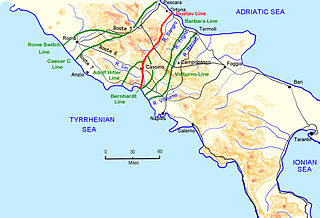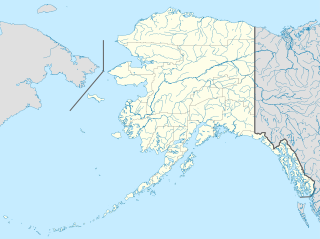Related Research Articles

Operation Torch was an Allied invasion of French North Africa during the Second World War. While the French colonies formally aligned with Germany via Vichy France, the loyalties of the population were mixed. Reports indicated that they might support the Allies. American General Dwight D. Eisenhower, supreme commander of the Allied forces in Mediterranean Theater of Operations, planned a three-pronged attack on Casablanca (Western), Oran (Center) and Algiers (Eastern), then a rapid move on Tunis to catch Axis forces in North Africa from the west in conjunction with Allied advance from east.

The Winter Line was a series of German and Italian military fortifications in Italy, constructed during World War II by Organisation Todt and commanded by Albert Kesselring. The series of three lines was designed to defend a western section of Italy, focused around the town of Monte Cassino, through which ran the important Highway 6 which led uninterrupted to Rome. The primary Gustav Line ran across Italy from just north of where the Garigliano River flows into the Tyrrhenian Sea in the west, through the Apennine Mountains to the mouth of the Sangro River on the Adriatic coast in the east. The two subsidiary lines, the Bernhardt Line and the Hitler Line ran much shorter distances from the Tyrrehnian sea to just North East of Cassino where they would merge into the Gustav Line. Relative to the Gustav Line, the Hitler Line stood to the North-West and the Bernhardt Line to the South-East of the primary defenses.

Operation Dragoon was the code name for the landing operation of the Allied invasion of Provence on 15 August 1944. The operation was initially planned to be executed in conjunction with Operation Overlord, the Allied landing in Normandy, but the lack of available resources led to a cancellation of the second landing. By July 1944 the landing was reconsidered, as the clogged-up ports in Normandy did not have the capacity to adequately supply the Allied forces. Concurrently, the French High Command pushed for a revival of the operation that would include large numbers of French troops. As a result, the operation was finally approved in July to be executed in August.

John Glenn Columbus International Airport is an international airport located 6 miles (9.7 km) east of downtown Columbus, Ohio. Formerly known as Port Columbus International Airport, it is managed by the Columbus Regional Airport Authority, which also oversees operations at Rickenbacker International Airport and Bolton Field. The airport code 'CMH' stands for "Columbus Municipal Hangar," the original name for the airport.

The Allied invasion of Italy was the Allied amphibious landing on mainland Italy that took place on 3 September 1943 during the early stages of the Italian campaign of World War II. The operation was undertaken by General Sir Harold Alexander's 15th Army Group and followed the successful Allied Invasion of Sicily. The main invasion force landed around Salerno on 9 September on the western coast in Operation Avalanche, while two supporting operations took place in Calabria and Taranto.

The Western Front was a military theatre of World War II encompassing Denmark, Norway, Luxembourg, Belgium, the Netherlands, the United Kingdom, France, Italy, and Germany. World War II military engagements in Southern Europe and elsewhere are generally considered as separate theatres. The Western Front was marked by two phases of large-scale combat operations. The first phase saw the capitulation of Luxembourg, Netherlands, Belgium, and France during May and June 1940 after their defeat in the Low Countries and the northern half of France, and continued into an air war between Germany and Britain that climaxed with the Battle of Britain. The second phase consisted of large-scale ground combat, which began in June 1944 with the Allied landings in Normandy and continued until the defeat of Germany in May 1945.

Sainte-Mère-Église is a commune in the northwestern French department of Manche, in Normandy. On 1 January 2016, the former communes of Beuzeville-au-Plain, Chef-du-Pont, Écoquenéauville and Foucarville were merged into Sainte-Mère-Église. On 1 January 2019, the former communes of Carquebut and Ravenoville were merged into Sainte-Mère-Église.

Operation Varsity was a successful airborne forces operation launched by Allied troops that took place toward the end of World War II. Involving more than 16,000 paratroopers and several thousand aircraft, it was the largest airborne operation in history to be conducted on a single day and in one location.

The 63rd Infantry Division was an infantry division of the United States Army that fought in Europe during World War II. After the war it was inactivated, but later the division number and shoulder sleeve insignia were authorized for use by the 63d Army Reserve Command (ARCOM).

Operation Northwind was the last major German offensive of World War II on the Western Front. It began on 31 December 1944 in Rhineland-Palatinate, Alsace and Lorraine in southwestern Germany and northeastern France, and ended on 25 January 1945. The German offensive was an operational failure, with its main objectives not achieved.

The Glider Badge was a special skills badge of the United States Army. According to the U.S. Army Institute of Heraldry, the badge was awarded to personnel who had "been assigned or attached to a glider or airborne unit or to the Airborne Department of the Infantry School; satisfactorily completed a course of instruction, or participated in at least one combat glider mission into enemy-held territory.

The Battle of Guam was the American recapture of the Japanese-held island of Guam, a U.S. territory in the Mariana Islands captured by the Japanese from the U.S. in the 1941 First Battle of Guam during the Pacific campaign of World War II.

The Allied advance from Paris to the Rhine, also known as the Siegfried Line campaign, was a phase in the Western European campaign of World War II.
The 47th Infantry Regiment is an infantry regiment of the United States Army. Constituted in 1917 at Camp Syracuse, New York, the regiment fought in the Great War, and was later inactivated in 1921. Reactivated in 1940, the regiment fought during World War II in North Africa, Sicily, and Western Europe, then was inactivated in 1946. During the Cold War, the regiment saw multiple activations and inactivations, with service both in the Regular Army and the Army Reserve; it fought in Vietnam. Ultimately it was reactivated as a training regiment, and as of 1999, it has been assigned to Fort Benning and consists of two active battalions.

The Landing at Aitape was a battle of the Western New Guinea campaign of World War II. American and Allied forces undertook an amphibious landing on 22 April 1944 at Aitape on northern coast of Papua New Guinea. The amphibious landing was undertaken simultaneously with the landings at Humboldt and Tanahmerah Bays to secure Hollandia to isolate the Japanese 18th Army at Wewak. Operations in the area to consolidate the landing continued until 4 May, although US and Japanese forces fought further actions in western New Guinea following a Japanese counter-offensive that lasted until early August 1944. Aitape was subsequently developed into an Allied base of operations and was used by Australian forces throughout late 1944 and into 1945 during the Aitape–Wewak campaign.
The 121st Signal Battalion was a signal unit of the United States Army, inactivated as of July 2006. Prior to deactivation, it provided signal support to the 1st Infantry Division.

Amchitka Air Force Base is an abandoned Air Force Base located on Amchitka, in the Rat Islands group of the Aleutian Islands in southwest Alaska.

Major General Roderick Random Allen was a senior United States Army officer, who commanded the 20th and 12th Armored Divisions during World War II. Under his command of the 12th AD, the division defended Strasbourg from recapture against overwhelming odds; it provided the armored contingent in the closure of the Colmar Pocket and the liberation of Colmar; it spearheaded General George Patton's drive to the Rhine; captured intact the remaining bridge over the Danube River and broke the German defense line, making it the first time in recorded history that the Danube had failed to stop an invading army; and played a major part in blocking the Brenner Pass, thereby trapping over a million German soldiers in Italy as the war ended. En route to the Brenner Pass it overran eleven concentration camps at Landsberg, Germany.

The Battle of Nuremberg was a five-day battle between the forces of the United States 7th Army on one side, and Nazi Germany and Russian Liberation Army volunteers on the other during World War II. The battle saw some of the fiercest urban combat during the war and it took four days for the United States to capture the city. The battle was a blow to Nazi Germany as Nuremberg was a center of the Nazi regime. The Nuremberg Rally took place in the city and to lose the city to the Americans took a heavy toll on already low German morale. Even though American forces heavily outnumbered the German forces, it wasn't until 20 April, that the 7th Army took the city center. The battle devastated the city.

The Landing at Amchitka was the amphibious landing operation and occupation of Amchitka island by American forces during the Aleutian Islands Campaign.
References
- ↑ Jeffrey J. Clarke and Robert Ross Smith, Riviera to the Rhine (1993). CMH Pub 7-10, cloth, GPO S/N 008-029-00213-2; CMH Pub 7-10-1, paper, GPO S/N 008-029-00229-9. "A history of combat operations by Sixth Army Group from its landing in southern France to its crossing of the Rhine."